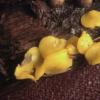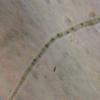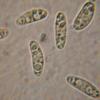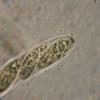
04-01-2026 17:45
 Stephen Martin Mifsud
Stephen Martin Mifsud
I was happy to find these orange asmocyetes which

03-01-2026 13:08
Niek SchrierHi all,We found groups of perithecia on a Lecanora

29-12-2025 17:44
Isabelle CharissouBonjour,J'aimerais savoir si d'autres personnes au

02-01-2026 17:43
MARICEL PATINOHi there, although I couldn't see the fruitbody, I

01-01-2026 18:35
Original loamy soil aside a artificial lake.The co

31-12-2025 19:27
Collected from loamy soil, at waterside (completel

Hello, forum!
There is Bisporella collected on Populus tremula.
Micro:
In statu vivo:spores ellipsoid, 14,9-19,3-3,6-5,5 um, with 2-3 large and many small guttules.
Paraphyses guttulate (photo is of low quality and I can attach the drawing if needed)
Asci with croziers, 8-spored, blued in IKI (see photo)
Is it B. citrina? If it is so, why paraphyses are guttulate?
Sincerely, Irina

the paraphysis is strange, it should contain a homogeneous content in the upper part. Otherwise I also think B. citrina. A section is always good, excipulum should be gelatinized and the hyphae with a almost vertical orientation.
Zotto

Yes, but be careful, maybe you ovelooked very elongated (with homogenous content) vacuolar bodies in apical cells (the microphoto is very blur) because sometimes they can be of +/- whole cell length. Considering small "guttules" they could be isolated/concentrated yellow carotenoid pigment - the situation I observed in some other ascomycetes with carotenoid pigments where pigment can be separated from VB's and/or LB's. In such cases VB's and LB's are often highly refractive and hyaline or nearly so while pigment are decidedly yellow to orange to red and low refractive if at all...
At least asci are clearly of Calycina type :-) !!
Cheers,
Neven

Thank you, Zotto and Neven!
Really, in the upper part paraphyses were not-guttulate (probably, gelatinous, but I cannot say it exactly). In the lower part paraphyses contained many small rounded guttules (it's not seen from photo but I saw them very clearly).
Sincerely,
Irina






